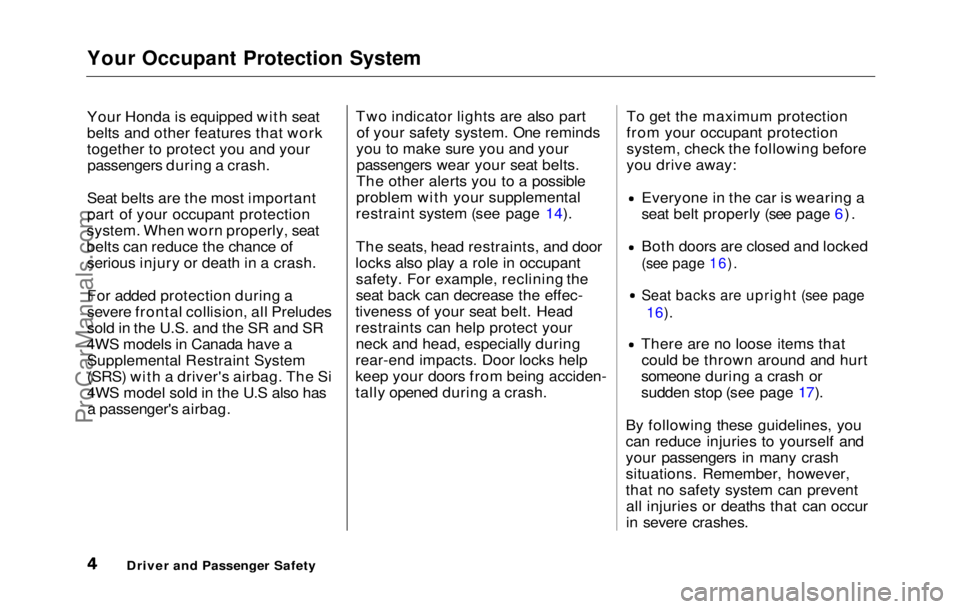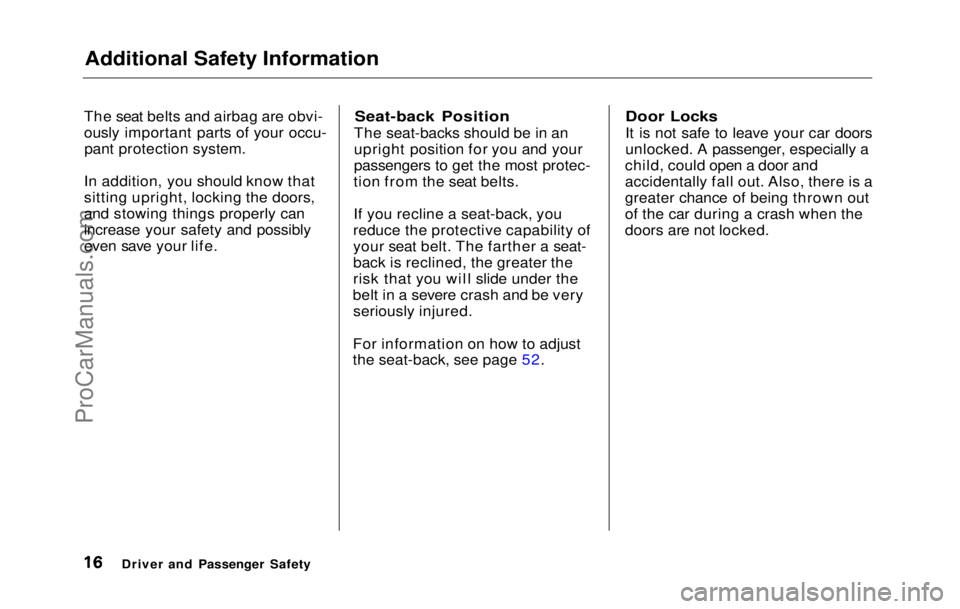1992 HONDA PRELUDE door lock
[x] Cancel search: door lockPage 4 of 225

Driver and Passenger Safety
This section gives you important
information about occupant protection. It shows how to use seat
belts properly. It explains the Supplemental Restraint System.
And it gives useful information about how to protect infants and
children in your car. Your Occupant Protection
System........................................ 4
The Seat Belt System
and How It Works.................... 5
Why Wear Seat Belts................... 5 Important Safety Reminders..... 5
Seat Belt System Components... 6
Lap/Shoulder Belt........................ 6
Wearing Seat Belts Properly...... 6
Wearing a Lap/Shoulder
Belt ............................................. 7
Advice for Pregnant Women..... 8 Seat Belt Maintenance................ 9
Supplemental Restraint System.. 10 Important Safety Reminder..... 11
How the Driver's Airbag
Works........................................ 12
How the Passenger's Airbag
Works........................................ 13
How the SRS Indicator Light
Works ...................................... 14
System Service.......................... .
14
System Service Precautions..... 15
Additional Safety Information .... 16 Seat-back Position..................... 16
Door Locks.................................. 16 Storing Cargo Safely ................
17
Driving wit
h
Pets....................... 17
Child Safety..................................... 18
Where Should Children Sit?..... 18
Important Safety Reminders... 19
General Guidelines
for Restraining Children Under 18 kg (40 Ibs)............... 19
Restraining an Infant Who Weighs Less Than 9 kg (20 Ibs)......... 20
Restraining a Child Who Weighs Between
9 and 18 kg (20 and 40 Ibs).... 20
Using Child Restraints with Tethers............................
21
Using a
Seat Belt
Locking Clip............................ 22
Restraining a Child Who Weigh
s
Over 1 8
kg (40 Ibs)..................
23
Storing a
Chil
d Seat...................
23
Alcohol and Drugs..........................
24
Carbon Monoxid
e
Hazard ............
25
Reporting Safet
y
Defects
(US Cars)......................................
26
Safety Labels .................................
27
Driver an d
Passenger SafetyProCarManuals.comMain Menu s t
Page 5 of 225

Your Occupant Protection System
Your Honda is equipped with seat
belts and other features that work
together to protect you and your
passengers during a crash.
Seat belts are the most important
part of your occupant protection
system. When worn properly, seat
belts can reduce the chance of serious injury or death in a crash.
For added protection during a
severe frontal collision, all Preludes
sold in the U.S. and the SR and SR
4WS models in Canada have a Supplemental Restraint System
(SRS) with a driver's airbag. The Si
4WS model sold in the U.S also hasa passenger's airbag. Two indicator lights are also part
of your safety system. One reminds
you to make sure you and your passengers wear your seat belts.
The other alerts you to a possible
problem with your supplemental
restraint system (see page 14).
The seats, head restraints, and door
locks also play a role in occupant safety. For example, reclining the
seat back can decrease the effec-
tiveness of your seat belt. Head
restraints can help protect your neck and head, especially during
rear-end impacts. Door locks help
keep your doors from being acciden-
tally opened during a crash. To get the maximum protection
from your occupant protection
system, check the following before
you drive away:
Everyone in the car is wearing a
seat belt properly (see page 6).
Both doors are closed and locked
(see page 16).
Seat backs are upright (see page
16).
There are no loose items that
could be thrown around and hurt
someone during a crash or
sudden stop (see page 17).
By following these guidelines, you
can reduce injuries to yourself and
your passengers in many crash
situations. Remember, however,
that no safety system can prevent all injuries or deaths that can occur
in severe crashes.
Driver and Passenger SafetyProCarManuals.comMain Menu Table of Contents s t
Page 17 of 225

Additional Safety Information
The seat belts and airbag are obvi-
ously important parts of your occu- pant protection system.
In addition, you should know that
sitting upright, locking the doors,
and stowing things properly can
increase your safety and possibly
even save your life.
Seat-back Position
The seat-backs should be in an
upright position for you and your
passengers to get the most protec-
tion from the seat belts.
If you recline a seat-back, you
reduce the protective capability of
your seat belt. The farther a seat-
back is reclined, the greater the
risk that you will slide under the
belt in a severe crash and be very seriously injured.
For information on how to adjust
the seat-back, see page 52.
Door Locks
It is not safe to leave your car doors
unlocked. A passenger, especially a
child, could open a door and
accidentally fall out. Also, there is a
greater chance of being thrown out
of the car during a crash when the
doors are not locked.
Driver and Passenger SafetyProCarManuals.comMain Menu Table of Contents s t
Page 18 of 225

Additional Safety Information
Storing Cargo Safely
Before you drive, make sure you
first securely store or tie down any items that could be thrown around
the car and hurt someone, or interfere with your ability to
operate the controls.
Do not put any items on top of the
rear shelf. They can block your
view and they could be thrown about the car in a crash.
Be sure to keep compartment doors
closed when the car is moving. If a
front passenger hits the door of an open glove box, for example, he
could injure his knees.
Driving with Pets
Loose pets can be a hazard while
you are driving. A loose pet can
interfere with your ability to drive
the car. In a crash or sudden stop,
loose pets or cages can be thrown
around inside the car and hurt you
or your passengers. It is also for
their safety that pets should be properly restrained in your car.
The recommended way to restrain
a medium-sized or larger dog is
with a special traveling harness.
This harness can be secured to the
rear seat with a seat belt. Travel
harnesses are available at pet
stores.
A small dog, cat, or other small
animal will be safest in a rigidly-
sided pet carrier. Choose a style
that allows you to secure it to the
car's seat by routing a seat belt
through the carrier's handle.
For further information, contact
your veterinarian or local animal
protection society.
Driver and Passenger SafetyProCarManuals.comMain Menu Table of Contents s t
Page 29 of 225

Instruments and Controls
This section gives information
about the controls and displays that
contribute to the daily operation of
your Honda. All the essential
controls are within easy reach.
Control Locations......................... 30
Indicator Lights.............................. 31
Gauges............................................. 37
Speedometer
.............................
37
Tachometer................................. 37
Odometer
.................................... 37
Trip Meter................................... 37
Fuel Gauge..................................
38
Temperature Gauge
..................
38
Controls Near the
Steering
Wheel
....................................... 39
Headlights................................... 40
Daytime Running Lights.......... 40
Instrument Panel Brightness... 41
Turn Signals................................ 41
Windshield Wipers.....................
42
Windshield Washers.................
42
Steering Wheel Adjustment ....
. 43
Steering Wheel Controls............... 44
Cruise Control............................ 44
Horn ............................................ 47
Keys and Locks.............................. 47
Keys.............................................. 47
Ignition Switch........................... 47
Door Locks.................................. 48
Power Door Locks ..................... 48
Trunk.......................................... 50
Seat Adjustments........................... 51
Rear Seat Access........................ 52
Additional Driver' s
Seat
Adjustments...........................
53
Seat Heaters.................................... 54
Folding Rea r
Seat.......................... 55
Hazard Warning............................ 56
Rear Window Defogger ................ 56
Power Windows.............................. 57
Sunroof ...........................................
58
Mirrors ........................................... 59
Parking Brake................................ .
61
Glove Box........................................
.
62
Digital Clock..................................
.
63
Center Console Compartment .... 64
Vanity
Mirror
..............................
64
Cigarette Lighter
..........................
.
65
Ashtray........................................... 65
Interior Lights...............................
.
66
Instruments an
d
ControlsProCarManuals.comMain Menu s t
Page 30 of 225

Control Locations
MIRROR
CONTROLS(P.60)
FUEL FILLER
DOOR RELEASE
(P.100) DOOR LOCK
SWITCH (P.49) POWER WINDOW
SWITCH
(P.57) DIGITAL CLOCK
(P.63)
TRUNK RELEASE HANDLE
(P.50)
HOOD RELEASE
HANDLE
(P.101)
HEATING/
COOLING
CONTROL
(P.68)
AUDIO SYSTEM (P.75, 84)
Instruments and ControlsProCarManuals.comMain Menu Table of Contents s t
Page 32 of 225

Indicator Lights
* The U.S. instrument panel is
shown. Differences for the Canadi-
an model are noted in the text.
Instruments and Controls
CRUISE CONTROL INDICATOR
LOW FUEL INDICATOR CHECK ENGINE LIGHT*
BRAKE LAMP
INDICATOR
TRUNK-OPEN INDICATOR DOOR-OPEN INDICATOR
LOW OIL PRESSURE LIGHT
CHARGING SYSTEM LIGHT SEAT BELT
REMINDER
LIGHT PARKING BRAKE
AND BRAKE
SYSTEM LIGHT* ANTI-LOCK BRAKE SYSTEM
INDICATORProCarManuals.comMain Menu Table of Contents s t
Page 35 of 225

Indicator Lights
Four Wheel Steering
System (4WS)
Indicator
Only on cars equipped with electronic
four wheel steering
This light normally comes on when you turn the ignition ON (II) and
goes off after the engine starts. If it
comes on at any other time, there is
a problem in the 4WS. If this
happens, stop the car in a safe placeand turn off the engine. Reset the
system by restarting the engine.
Watch the 4WS light. If it does not
go off, or comes back on again
while driving, take the car to yourdealer to have the system checked.
The 4WS system is disabled with this light on. The rear wheels are
locked straight ahead, and your car
steers like a conventional car
without 4WS.
Turn Signal and
Hazard Warning
Indicators
The left or right turn signal light
blinks when you signal a lane change or turn. If the light does not
blink or blinks rapidly, it usually
means one of the turn signal bulbs is burned out (see page 164).Replace it as soon as possible, since
other driver s
cannot see that you
are signaling.
When you turn on the Hazard
Warning switch, both turn signal
lights blink. All turn signals on the outside of the car should flash.
High Beam Indicator
This light comes on with the high
beam headlights. See page 40 for information on the headlight
controls.
Instruments and Controls
4WS
Low fuel Indicator
This light comes on as a reminder
that you must refuel soon.
Cruise Control
Indicator
This lights when you set the cruise control. See page 44 for informa-
tion on operating the cruise control.
Trunk-open Indicator
This light comes on if the trunk lid
is not closed tightly.
Door-open Indicator
This light comes on if either door is
not closed tightly.
CRUISE
CONTROL
ProCarManuals.comMain Menu Table of Contents s t